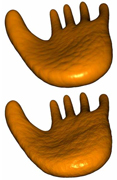Multiresolution Displacement Mapping on Subdivision Surfaces

Autor: Przemyslaw Musialski
Betreuer: Prof. Dr. Charles A. Wüthrich
In computer graphics subdivision surfaces is a technique to create smooth surfaces out of coarse polyhedral nets. Moreover it is capable of creating excellent high-density tessellations on todays hardware in real-time. Additionally, due to the recursive generation nature it is also ideally suited for adding geometric detail in different resolutions. When modeling real world surfaces it is possible to use image samples to recover wrinkled characteristics of a material and apply these on dense discrete meshes in the form of vertices displacement. Material characteristics are a mixture of features of different sizes which can be recovered by a frequency decomposition of an input height map. These sub-bands can be successively applied on different resolutions of the subdivision evaluation process in order to achieve naturally looking objects.
Although this can be done in software, the resulting amount of data and the processing time are prohibitively large. This thesis presents a method for computing displaced subdivision surfaces on the GPU that can render overlapping patches of the surface independently from each other without loss of mesh coherence. Thus, this method is ideally suited for onthe- fly generation of geometric detail as demanded by the viewing position of a rendering application.
The main goal of this thesis is to develop a method for generating naturally looking subdivision surfaces. It is a part of the basic research project GeomeTree [VG04] of the VRVis Company in Vienna, which aims at developing a wide variety of techniques for vegetation visualization. It is split into several sub-areas beginning with a rendering of complete landscapes of forests to creating small details in extreme closeup views. In previous work Catmull-Clark subdivision surfaces over a set of loosely joined meshes have been implemented by the author [MTM07]. In the current thesis the focus has been set on small features on the otherwise completely smooth surfaces. In order to achieve this, it become apparent very quickly that only very high tessellated surfaces provide a background for synthesizing naturally looking details. While subdivision surfaces as implemented in software do not allow for such high resolutions in reasonable time, the decision was made to implement this technique in graphics hardware.
In order to generate details on the surface, the technique of displacement mapping seems to be the tool of choice. While displacement is usually applied on already tessellated meshes, in terms of recursive subdivision evaluation it seems to be an interesting issue that takes advantage of the multiresolution representation of the surface. Thus, the approach of developing a procedural displacement in different resolutions leaning on reconstruction of patterns on given samples will be attempted.
Material:
